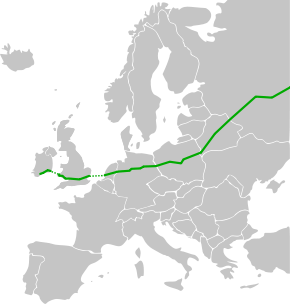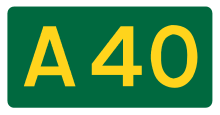European route E30
| |
|---|---|
 | |
| Major junctions | |
| From: | Cork (Ireland) |
| To: | Omsk (Russia) |
| Location | |
| Countries: | Republic of Ireland, United Kingdom, Netherlands, Germany, Poland, Belarus, Russia |
| Highway system | |
| International E-road network | |
European route E 30 is an A-Class West-East European route, extending from the southern Irish port of Cork in the west to the Russian city of Omsk in the east. For much of its Russian stretch, it coincides with Trans-Siberian Highway and, east of the Ural Mountains, with AH6 of the Asian Highway Network, which continues to Busan, South Korea. This route is approximately 6,500 kilometres (4,000 mi).
History
The E 30 is one of the longest European routes with a total length of about 5,800 km (3,600 mi)—3,300 km (2,100 mi) from Cork to Moscow, and 2,500 km (1,600 mi) from Moscow to Omsk. The naming is by the United Nations Economic Commission for Europe.
Formerly the route only went from Cork to Samara, with an often reported length of 4,912 km (3,052 mi).
Formerly, before 1985, this was the E 8 (London–Berlin–Brest).
Itinerary
Although the United Kingdom Government participates fully in activities concerning the E-routes,[1] E-routes are not signposted within the United Kingdom.
 Fishguard – Carmarthen
Fishguard – Carmarthen Carmarthen – Llanelli
Carmarthen – Llanelli Llanelli – Swansea – Cardiff – Newport – Newbury (
Llanelli – Swansea – Cardiff – Newport – Newbury ( ) – Slough
) – Slough Slough - Watford (
Slough - Watford ( ) - Greater London (
) - Greater London ( ) – Brentwood
) – Brentwood Brentwood – Chelmsford – Colchester (
Brentwood – Chelmsford – Colchester ( ) –Ipswich (
) –Ipswich ( )
) Ipswich (
Ipswich ( ) – Felixstowe
) – Felixstowe
The nearest passenger ferries to Hoek van Holland actually depart from Harwich, across the Orwell south of Felixstowe. That ferry has 2 daily departures, one is a day crossing, the other a night crossing, both taking about 7–8 hours. It carries foot (train) passengers as well as cars, buses, caravans and freight lorries.[2] Ferries departing from Felixstowe carry freight only.
- Gap
 The Netherlands
The Netherlands
 Hoek van Holland (
Hoek van Holland ( ) – Den Haag
) – Den Haag Den Haag (
Den Haag ( )
) Den Haag (
Den Haag ( ) – Gouda (Start of concurrency with
) – Gouda (Start of concurrency with  )– Utrecht (
)– Utrecht (
 , End of Concurrency with
, End of Concurrency with  )
) Utrecht (
Utrecht (
 )
) Utrecht – Amersfoort (
Utrecht – Amersfoort (
 )
) Amersfoort (
Amersfoort (
 ) – Borne
) – Borne
 Borne
Borne Borne - Oldenzaal
Borne - Oldenzaal
 Germany
Germany
 Bad Bentheim – Osnabrück (
Bad Bentheim – Osnabrück ( ) – Bünde – Bad Oeynhausen
) – Bünde – Bad Oeynhausen Bad Oeynhausen
Bad Oeynhausen Bad Oeynhausen (
Bad Oeynhausen ( )
) Bad Oeynhausen (
Bad Oeynhausen ( ) – Hanover (
) – Hanover ( ) – Magdeburg (
) – Magdeburg ( - Potsdam (
- Potsdam ( )
) Potsdam (
Potsdam ( ) - Berlin (
) - Berlin (
 ) - Königs Wusterhausen (
) - Königs Wusterhausen ( )
) Königs Wusterhausen (
Königs Wusterhausen ( ) - Frankfurt an der Oder
) - Frankfurt an der Oder
 Poland
Poland
_3_km_east_of_Pozna%C5%84_Komorniki_interchange.jpg)
 Świecko - Świebodzin (
Świecko - Świebodzin ( ) - Poznań (
) - Poznań ( ) - Łódź (
) - Łódź ( ) - Łowicz Warsaw (
) - Łowicz Warsaw (
 )
) Warsaw (
Warsaw (
 )
) Warsaw - Sulejówek (
Warsaw - Sulejówek ( ) - Mińsk Mazowiecki
) - Mińsk Mazowiecki Mińsk Mazowiecki
Mińsk Mazowiecki Mińsk Mazowiecki - Siedlce - Biała Podlaska - Wólka Dobryńska - Terespol
Mińsk Mazowiecki - Siedlce - Biała Podlaska - Wólka Dobryńska - Terespol Wólka Dobryńska - Kukuryki
Wólka Dobryńska - Kukuryki
 Belarus
Belarus
 Brest - Kobryn (Start of Concurrency with
Brest - Kobryn (Start of Concurrency with  ) - Ivatsevichy (End of Concurrency with
) - Ivatsevichy (End of Concurrency with  ) - Baranavichy - Minsk (
) - Baranavichy - Minsk ( , Towards
, Towards  ) - Barysaw - Orsha (
) - Barysaw - Orsha ( ) - Dubroŭna
) - Dubroŭna
 Russia
Russia
The Russian stretch of this road coincides partly with the Asian Highway Network's AH6 (though this latter highway passes through Petropavl, Kazakhstan in its stretch between Chelyabinsk and Omsk, unlike the E 30). The E 30 follows the Russian main road M1 Belarus-Moscow, M5 Moscow-Chelyabinsk and M51 Chelyabinsk-Kurgan. It goes along minor roads past Ishim to avoid the Kazak border towards Omsk.
Trivia
In the years 1988-1994, a travel agency in the Netherlands, called E30, organized trips with a camper-touring car along the E30, starting at Utrecht and with stops in Berlin, Warsaw, Minsk, Smolensk and end destination Moscow.
See also
- Category:Constituent roads of European route E30
References
- ↑ For example Economic and Social Council Document ECE/TRANS/WP.6/AC.2/18 – 17 December 2008; Agenda item 6 Participation in the 2005 E-route census
- ↑ For more information see: StenaLine or The Man in Seat 61 Seat61
External links
| Wikimedia Commons has media related to E 30. |

